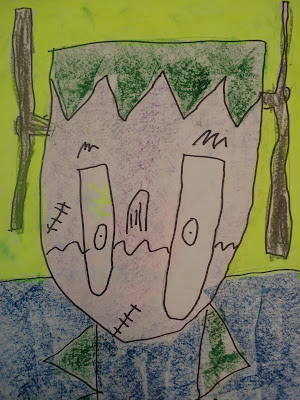This is a very cool resist effect which I thought was suitable for Halloween art. If you don't celebrate Halloween in your school and/or country, pumpkins or leaves would be a nice Autumn theme alternative.
This project is a take on
'tempera batik', but instead of a layer of thick tempera paint, this is a simpler version using oil pastels. I will warn you- this *can* be a tricky process and results vary according to different materials, brands, etc. I suggest to try it out yourself first to perfect the technique before you teach it to a class. You can also see my tempera batik lesson
here.
Here's what you need:
oil pastels
basic chalk (yellow, whatever you have)
black acrylic paint or India ink or black liquid watercolours
heavy white paper (I used smooth cardstock)
Start by drawing your Halloween (or pumpkin) image with pencil.
Outline all pencil lines with a thick line of chalk. I included a border as well.
The chalk lines will end up black in the end.
Now colour in the image with a thick layer of oil pastels. You don't need to fill in all the white paper, but you do need to layer on the oil pastels really thick. You can also try this will wax crayons, but I felt the results weren't as bright. But it does work.
Once you're finished colouring, you can wipe off some of the chalk with a slightly damp sponge.
Now paint over a layer of watered down black acrylic paint or India ink over the entire image.
*Important* Drying time seems to be the touchy part of this process. I used acrylic paint and let it sit just 5 minutes before I washed it off. India ink might be different. Test it first yourself.
Now take it to the sink and gently sprinkle it with some warm water to soften the paint. In the class, I stand by the sink and wash each student's one at a time (I know...). It seems to work out fine as most students work at different paces, so there's never really a mad rush for the sink.
It's just so easy to get this part wrong: turn the water on too hard and your paper rips, wipe too hard and the paper rips, wipe too little, etc.
Ok- so let it soak a bit, then gently run a small trickle of warm water over the paper- gently 'scrub' off the paint with your fingertips. You will find that it will come off quite easily from the oil pastels part. Don't rub all of it off- leave some bits sticking here and there for the resist effect.


Don't go answering the phone or something at this stage- once, I was washing these after school, and I was actually letting one soak in the sink full of water (I think I used India ink that time and it's harder to get off) and a teacher came in to talk to me, and I completely forgot about the art. The next day I came in to find a clump of dissolved paper mush in the sink. I managed to salvage a piece about 2 inches wide. I mounted it and returned it to the student with an "A+" written on the back. The student, thankfully,wasn't upset as he was super easy-going (and wasn't even close to being an 'A' student so he was actually happy!) We had a good laugh about it as a class and I told them it was a lesson for me in paying attention to the task at hand.
Anyway, so once you've taken off the amount of paint that you like, let it drip dry a bit and then place it in the drying rack or a stack of newspapers to dry. The paper's wet and fragile at this stage, so be careful.
Once dry, if you find too much black paint has come off in certain areas (it happens), you can always go back in with a thin brush and touch it up with more black paint. Like I said, it can be an unpredicatble process, but it's an interesting process.
Here's some previous Grade 6 results:
 |
| This one was made with wax crayons. |






















































